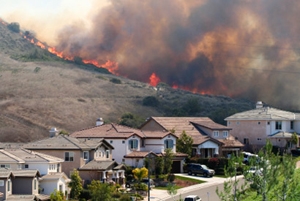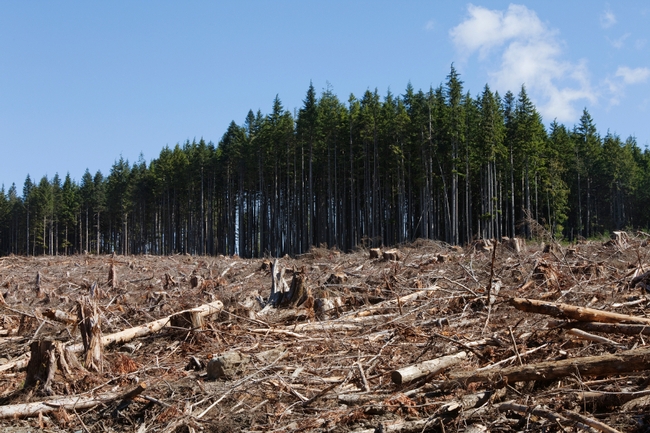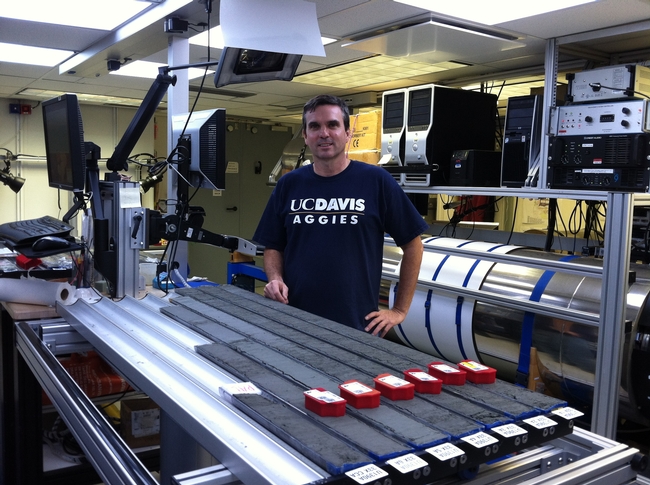Posts Tagged: climate change
Wildfires ignite debate on global warming
UC Cooperative Extension specialist Max Moritz has noticed that reporters are displaying a keen interest in the role played by global warming in what has so far been an unusually fierce 2012 fire season.
"For me, that marks a significant shift," wrote Moritz in a op-ed published in Nature yesterday. "This fresh curiosity about the link between fire and climate change is an important opportunity, of sorts."
Moritz, a wildfire expert in the UC Berkeley Department of Environmental Science, Policy and Management, is the author of a journal article published this summer in Ecosphere that linked climate change to global fire activity. The article is cited on a press release from U.S. House of Representatives Natural Resources Committee Democrats that calls for a hearing about reducing wildfire risk.
In the Moritz op-ed, he notes that a second common question from the press about the 2012 fire season is: “If these fires are related to climate change, what can we do about it?”
The inquiry, he said, reveals a growing anxiety over how humanity can adapt to the fire-related impacts of climate change, rather than how to mitigate climate change itself.
"To co-exist with fire will require extending our approach to living with environmental risks," Moritz wrote. "Mapping other natural hazards, such as flood and earthquake zones, has taught us to avoid building on the most dangerous parts of the landscape or to engineer solutions into the built environment when we do. Encouraging the 'right kind of fire' — with frequencies, sizes and intensities appropriate to the ecosystem in question — will be necessary, where possible, so that 'record-breaking' fires are less likely to occur during 'record-breaking' heat or drought."

For some people, climate change will become a fact only when its effects hit close to home.
UC scientist weighs in on climate change on VOA Russia
Common ground in the climate change debate can be found in agreement over the need to adapt to warmer temperatures, said Mark Lubell, a professor in the UC Davis Department of Environmental Science and Policy, during an interview with Rob Sachs of Voice of America Russia edition.
Lubell said there is a wide consensus among scientists that longterm climate models show a warming trend. There is less agreement about the cause of the warming temperatures, but most everyone would support the effort to make communities more resilient to the probable affects of a warmer planet.
Lubell said people need to be ready to adapt to more heat waves, a rising sea level and more fires in arid areas. He also discussed the potential repercussions of climate change on California agriculture.
"Climate change is likely to have a pretty big impact on water availability and the productivity of different types of crops," Lubell said "A farmer who says I'm just going to do what I've always done, 10 years from now might find himself with a much less profitable agricultural enterprise. If they try to change crops and the ways they manage their crop to be more in sync with climate change, they may be able to maintain their enterprise and profitability at the levels that they want."

Adapting to climate change is critical whether one believes it's human caused or not.
Climate change will alter risk of wildfire worldwide

By the end of the century, almost all of North America and most of Europe is projected to see a jump in the frequency of wildfires, primarily because of increasing temperature trends. At the same time, fire activity could actually decrease around equatorial regions, particularly among the tropical rainforests, because of increased rainfall.
The study, to be published Tuesday, June 12, in Ecosphere, an open-access, peer-reviewed journal of the Ecological Society of America, used 16 different climate change models to generate what the researchers said is one of the most comprehensive projections to date of how climate change might affect global fire patterns.
"In the long run, we found what most fear — increasing fire activity across large parts of the planet," said study lead author Max Moritz, fire specialist in UC Cooperative Extension. "But the speed and extent to which some of these changes may happen is surprising."
"These abrupt changes in fire patterns not only affect people's livelihoods," Moritz added, "but they add stress to native plants and animals that are already struggling to adapt to habitat loss."
The projections emphasize how important it is for experts in conservation and urban development to include fire in long-term planning and risk analysis, added Moritz, who is based at UC Berkeley’s College of Natural Resources.
UC Berkeley researchers worked with an atmospheric scientist from Texas Tech University to combine over a decade of satellite-based fire records with historical climate observations and model simulations of future change. The authors documented gradients between fire-prone and fire-free areas of Earth, and quantified the environmental factors responsible for these patterns. They then used these relationships to simulate how future climate change would drive future fire activity through the coming century as projected by a range of global climate models.
"Most of the previous wildfire projection studies focused on specific regions of the world, or relied upon only a handful of climate models," said study co-author Katharine Hayhoe, associate professor and director of the Climate Science Center at Texas Tech University. "Our study is unique in that we build a forecast for fire based upon consistent projections across 16 different climate models combined with satellite data, which gives a global perspective on recent fire patterns and their relationship to climate."
The fire models in this study are based on climate averages that include mean annual precipitation and mean temperature of the warmest month. These variables tend to control long-term biomass productivity and how flammable that fuel can get during the fire season, the researchers said.
Variables that reflect more ephemeral fluctuations in climate, such as annual rainfall shifts due to El Niño cycles, were not included because they vary over shorter periods of time, and future climate projections are only considered representative for averages over time periods of 20-30 years or longer, the authors said.
The study found that the greatest disagreements among models occur for the next few decades, with uncertainty across more than half the planet about whether fire activity will increase or decrease. However, some areas of the world, such as the western United States, show a high level of agreement in climate models both near-term and long-term, resulting in a stronger conclusion that those regions should brace themselves for more fire.
"When many different models paint the same picture, that gives us confidence that the results of our study reflect a robust fire frequency projection for that region," said Hayhoe. "What is clear is that the choices we are making as a society right now and in the next few decades will determine what Earth’s climate will look like over this century and beyond."
Study co-author David Ganz, who was director of forest carbon science at The Nature Conservancy at the time of the study, noted the significance of the findings for populations that rely upon fire-sensitive ecosystems.
"In Southeast Asia alone, there are millions of people that depend on forested ecosystems for their livelihoods," he said. "Knowing how climate and fire interact are important factors that one needs to consider when managing landscapes to maintain these ecosystem goods and services."
The researchers noted that the models they developed focused on fire frequencies, and that linking these to other models of fire intensity and vegetation change are important next steps.
"Our ability to model fire activity is improving," said Moritz, "but a more basic challenge is learning to coexist with fire itself."
The Natural Sciences and Engineering Research Council of Canada, the U.S. Forest Service, the National Science Foundation and The Nature Conservancy helped support this study.
RELATED INFORMATION
- Climate change to spur rapid shifts in fire hotspots, projects new analysis (2009 UC Berkeley press release)
When, where and how wood is used impacts carbons emissions
How wood is used after it is cleared from a forest and where that forest is located largely affects the amount of greenhouse gas emissions released into the atmosphere, according to a new study by UC Davis.
The study, published this week in the advance online edition of the journal Nature Climate Change, provides a deeper understanding of the complex global impacts of deforestation on carbon storage and greenhouse gas emissions.
When trees are felled to create solid wood products, such as lumber for housing, that wood retains much of its carbon for decades, the researchers found. In contrast, when wood is used for bioenergy or turned into pulp for paper, nearly all of its carbon is released into the atmosphere. Carbon is a major contributor to greenhouse gases.
“We found that 30 years after a forest clearing, between 0 percent and 62 percent of carbon from that forest might remain in storage,” said lead author J. Mason Earles, a doctoral student with the UC Davis Institute of Transportation Studies. “Previous models generally assumed that it was all released immediately.”
The researchers analyzed how 169 countries use harvested forests. They learned that the temperate forests found in the United States, Canada and parts of Europe are cleared primarily for use in solid wood products, while the tropical forests of the Southern Hemisphere are more often cleared for use in energy and paper production.
“Carbon stored in forests outside Europe, the USA and Canada, for example, in tropical climates such as Brazil and Indonesia, will be almost entirely lost shortly after clearance,” the study states.
The study’s findings have potential implications for biofuel incentives based on greenhouse gas emissions. For instance, if the United States decides to incentivize corn-based ethanol, less profitable crops, such as soybeans, may shift to other countries. And those countries might clear more forests to make way for the new crops. Where those countries are located and how the wood from those forests is used would affect how much carbon would be released into the atmosphere.
Earles said the study provides new information that could help inform climate models of the Intergovernmental Panel on Climate Change, the leading international body for the assessment of climate change.
“This is just one of the pieces that fit into this land-use issue,” said Earles. Land use is a driving factor of climate change. “We hope it will give climate models some concrete data on emissions factors they can use.”
In addition to Earles, the study, “Timing of carbon emissions from global forest clearance,” was co-authored by Sonia Yeh, a research scientist with the UC Davis Institute of Transportation Studies, and Kenneth E. Skog of the U.S. Department of Agriculture Forest Service.
The study was funded by the California Air Resources Board and the David and Lucile Packard Foundation.
Cruise to uncover climate change

UC Davis geophysicist Gary Acton is one of 34 international scientists that set sail from the Azores Islands on Nov. 17 aboard the drilling vessel JOIDES Resolution. They finished their Mediterranean voyage on Jan. 17, docking in Lisbon, Portugal.
“The climate change recovered at one of the drill sites will be dedicated to providing the most complete marine record of climate change over the past 2 million years of Earth’s history,” said Acton.
The vessel is run by the Integrated Ocean Drilling Program and has the unique ability to core into the deepest reaches of the ocean. The IODP Expedition 339 targeted thick sediment drifts that accumulated from warm, salty water—called Mediterranean Outflow Water—flowing from the Mediterranean through the Strait of Gibraltar. The researchers drilled, sampled and analyzed the sediment to understand the influence that the MOW water mass has on climate, sea level change and the environment.
“A fascinating aspect of these sediments is their ability to record subtle changes in environmental conditions through measurable changes,” said Acton.
Made heavy by its high salt content, the MOW’s warm waters plunge over 3,000 feet—a drop greater than that of Angel Falls, the world’s highest waterfall—into the Atlantic Ocean. It scours the rocky seafloor, coursing along the margins of Spain and Portugal. Passing Scotland and heading toward Norway, the MOW becomes part of the global conveyor belt that overturns the oceans and circulates water and heat around the globe. Along its journey, sand, silt, clay and microorganisms are deposited along the continental margin as thousands of layers of mud, eventually building into sediment drifts. Each layer contains information about Earth’s history.
“My goal is to reconstruct centennial-scale changes in climate and in Earth’s magnetic field for a time period spanning the past 400,000 years,” said Acton. “Only thick, rapidly deposited sedimentary units like those we are coring provide that ability. They are virtual prehistoric observatories.”
During the expedition, the scientists sailed more than 1,200 nautical miles, drilled 19 holes in 7 different locations, and collected 681 sediment cores—equal to about three miles of mud and sand. Now that the researchers have returned to their homes, they will continue to collaborate as they sift through the data.
“Part of the true value of participating on an expedition like this is the incredible amount of science that can be completed, particularly when scientists with a variety of expertise are confined to a 471-foot-long ship and asked to work 12-hour shifts for two months,” said Acton. “That may seem an odd thing to do over the holidays, but we were all thrilled to be a part of this expedition and to have the chance to continue to work together following the cruise.”